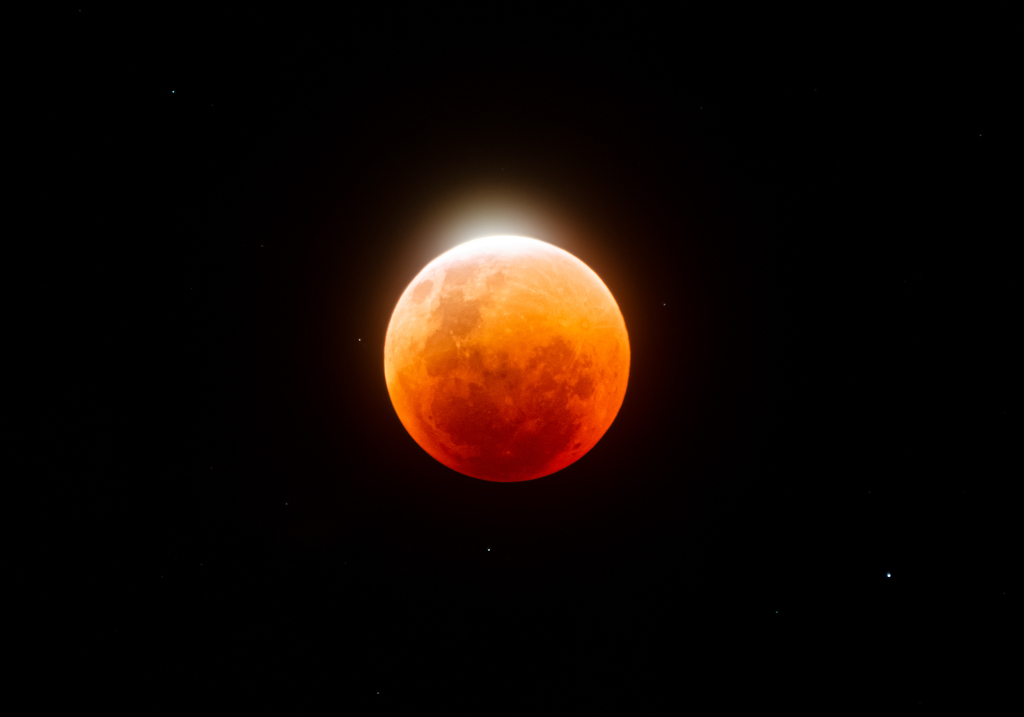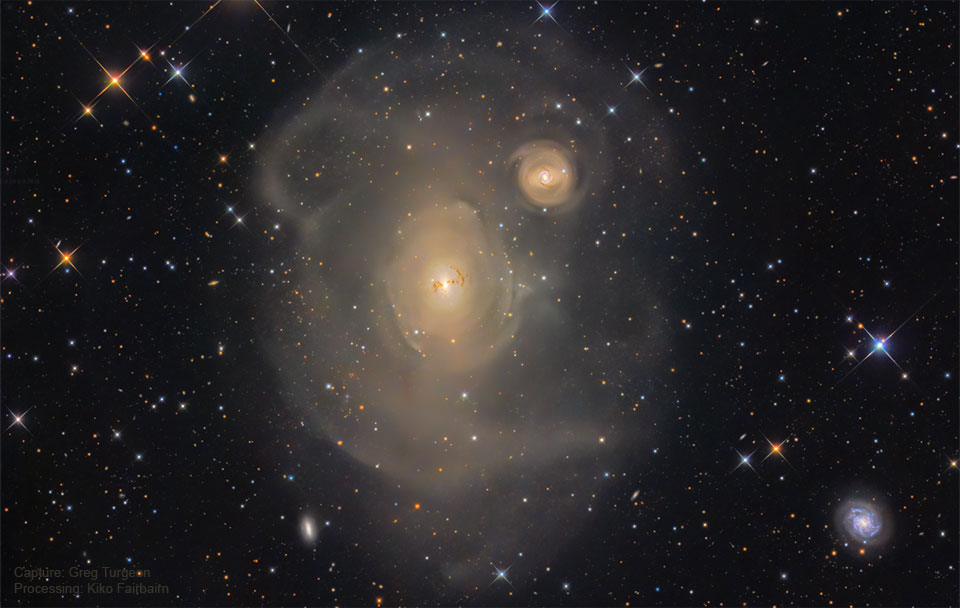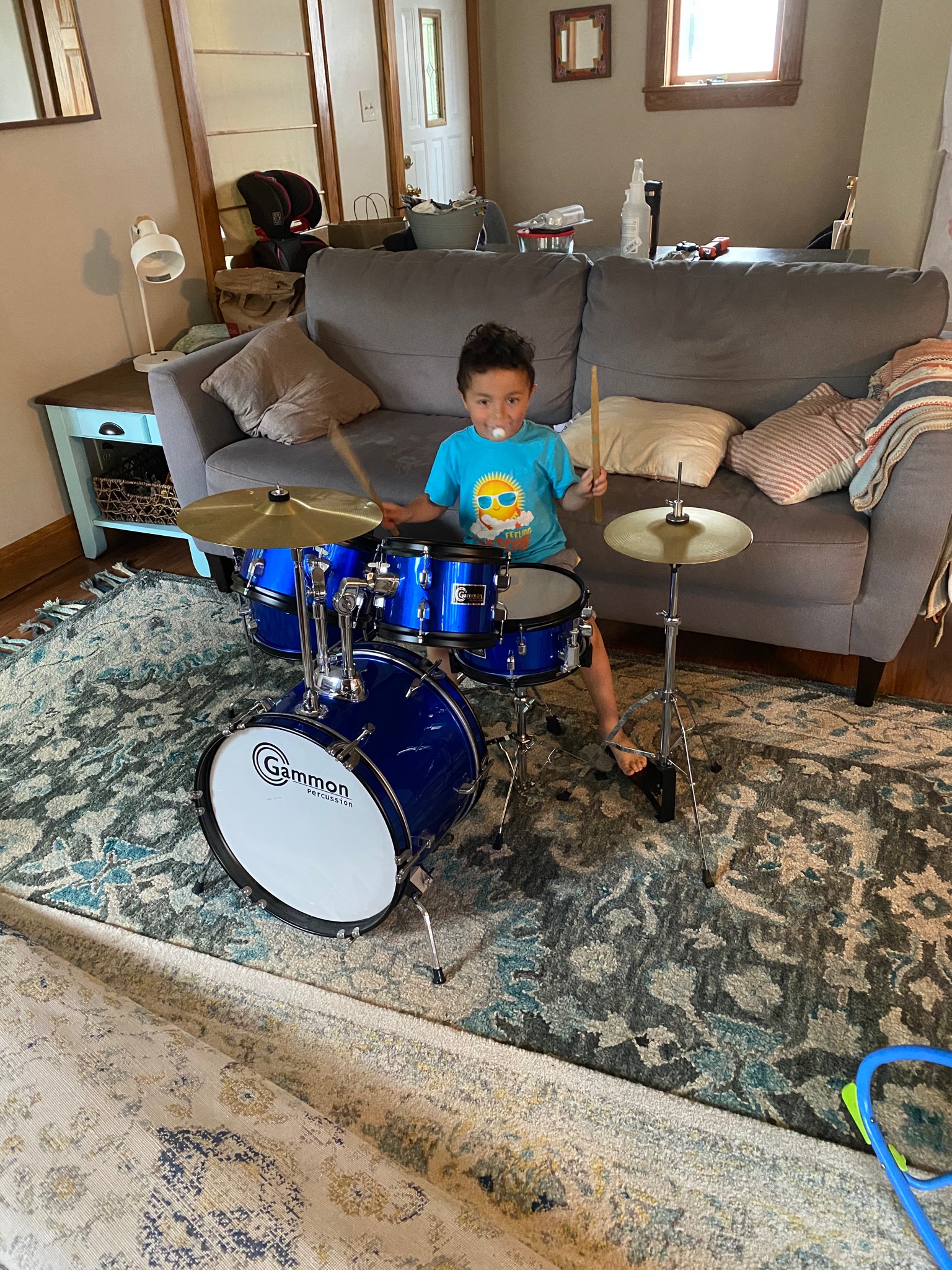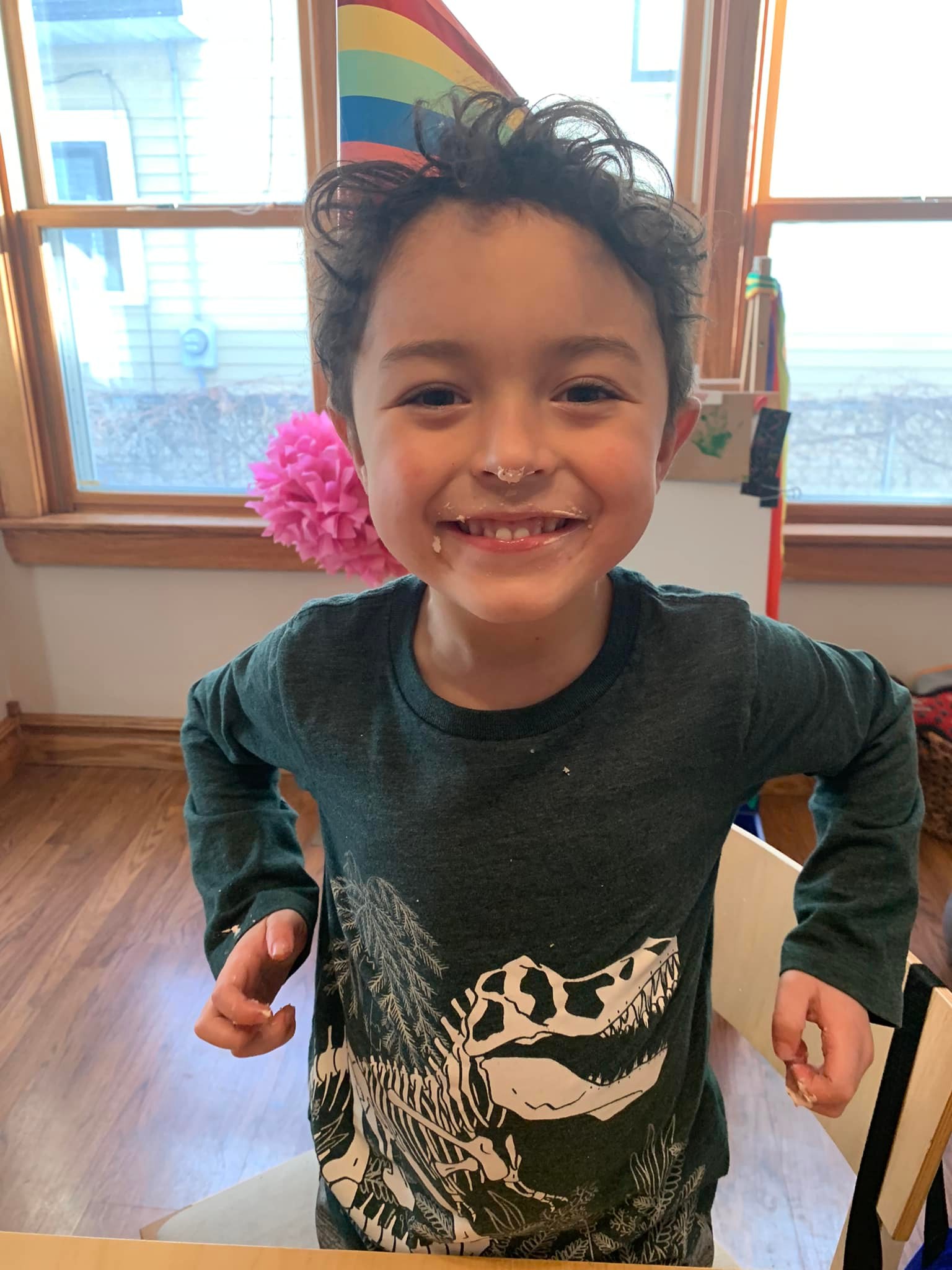Blog
Cloudy skies plagued some sky watchers on Sunday May 15th 2022 as May’s Full Flower Moon slipped through Earth’s shadow in a total lunar eclipse. In skies above Chile’s Atacama desert this telephoto snapshot still captured an awesome spectacle though. Seen through thin high cirrus clouds just before totality began, a last sliver of sunlit crescent glistens like a hazy jewel atop the mostly shadowed lunar disk. This full moon was near perigee, the closest point in its elliptical orbit. It passed near the center of Earth’s dark umbral shadow during the 90 minute long total eclipse phase. Faintly suffused with sunlight scattered by the atmosphere, the umbral shadow itself gave the eclipsed moon a reddened appearance and the very dramatic popular moniker of a Blood Moon.

Feliciano Vierra Tavares, Jr. aka Butch. (b. May 18, 1948). Vocalist in American R&B, funk, and soul music group, Tavares.
The brothers, whose parents were of Cape Verdean descent, started performing in 1959 as Chubby and the Turnpikes when the youngest brother was 9. P-Funk keyboardist/architect Bernie Worrell briefly joined the group in 1968 while attending the New England Conservatory of Music. Future Aerosmith drummer Joey Kramer appeared as the “token white-guy drummer” in a later incarnation called The Turnpikes from the fall of 1969 until September 1970, when he was invited to join Aerosmith. He was later replaced with drummer Paul Klodner and Bassist Steve Strout which gave them a tight a punchy rhythm section. Chubby and The Turnpikes signed with Capitol Records in 1967 and had a couple of local hit records including “I Know The Inside Story” in 1967 and “Nothing But Promises” in 1968. By 1973, they had changed their name to Tavares and scored their first R&B Top 10 (Pop Top 40) hit with “Check it Out”, and soon began charting regularly on the R&B and pop charts. Their first album included their brother Victor, who sang lead on “Check it Out”, but dropped out of the group shortly afterward. In 1974 Tavares had a #1 R&B hit with Hall & Oates’s “She’s Gone”, (which became a hit for Hall & Oates as well two years later).
1975 turned out to be their most successful year chartwise, with a Top 40 Pop album (In the City), the #25 hit “Remember What I Told You to Forget”, and their biggest hit, the Top 10 Pop/#1 R&B smash “It Only Takes a Minute”, which was later successfully covered by both Jonathan King and Take That, and sampled by Jennifer Lopez. They parlayed this success into a spot as an opening act for The Jackson 5. KC and The Sunshine Band was also on this tour. “Minute” was followed by a string of hits: “Heaven Must Be Missing an Angel” (1976), “Don’t Take Away the Music” (1976), and “Whodunit” (1977, another #1 R&B hit). In 1977 they also recorded “I Wanna See You Soon”, a duet with Capitol labelmate Freda Payne which received airplay on BBC Radio 1 but failed to chart.
Many of their hits, however, underplayed their R&B background and gave the group the image of being a disco act. This perception was reinforced by their appearance on the soundtrack to the film Saturday Night Fever in 1977. Tavares recorded the Bee Gees song “More Than a Woman”, and their version reached the Pop Top 40 that year. The soundtrack became one of the most successful in history, giving Tavares their only Grammy.
Later albums, such as Madam Butterfly and Supercharged, strayed from the disco format and were less successful on the pop chart (although they continued to have Top 10 R&B hits such as “Never Had a Love Like This Before” and the popular sociopolitical “Bad Times” written by British singer-songwriter Gerard McMahon). At the start of the 1980s, Tavares left Capitol Records, signing with RCA. They had one last major hit, the ballad “A Penny for Your Thoughts”, for which they were nominated for a Grammy in 1982; their last major release was Words and Music in 1983.
more...Kai Chresten Winding (May 18, 1922 – May 6, 1983) was a Danish-born American trombonist and jazz composer. He is known for his collaborations with trombonist J. J. Johnson. His version of “More“, the theme from the movie Mondo Cane, reached in 1963 number 8 in the Billboard Hot 100 and remained his only entry here.
Winding was born in Aarhus, Denmark. His father, Ove Winding was a naturalized U.S. citizen, thus Kai, his mother and sisters, though born abroad were already U.S. citizens. In September 1934, his mother, Jenny Winding, moved Kai and his two sisters, Ann and Alice. Kai graduated in 1940 from Stuyvesant High School in New York City and that same year began his career as a professional trombonist with Shorty Allen’s band. Subsequently, he played with Sonny Dunham and Alvino Rey,[2] until he entered the United States Coast Guard during World War II.
more...Joseph Vernon “Big Joe” Turner Jr. (May 18, 1911 – November 24, 1985) was an American blues shouter from Kansas City, Missouri. According to songwriter Doc Pomus, “Rock and roll would have never happened without him.” His greatest fame was due to his rock-and-roll recordings in the 1950s, particularly “Shake, Rattle and Roll“, but his career as a performer endured from the 1920s into the 1980s. Turner was inducted into the Rock and Roll Hall of Fame in 1987, with the Hall lauding him as “the brawny voiced ‘Boss of the Blues'”.
Turner was born May 18, 1911, in Kansas City, Missouri, United States. His father was killed in a train accident when Turner was four years old. He sang in his church, and on street corners for money. He left school at age fourteen to work in Kansas City’s nightclubs, first as a cook and later as a singing bartender. He became known as “The Singing Barman”, and worked in such venues as the Kingfish Club and the Sunset, where he and his partner, the boogie-woogie pianist Pete Johnson, became resident performers. The Sunset was managed by Piney Brown. It featured “separate but equal” facilities for white patrons. Turner wrote “Piney Brown Blues” in his honor and sang it throughout his career.
more...
Robert Reiniger Meredith Willson (May 18, 1902 – June 15, 1984) was an American flutist, composer, conductor, musical arranger, bandleader, playwright, and author. He is best known for writing the book, music, and lyrics for the 1957 hit Broadway musical The Music Man and “It’s Beginning to Look a Lot Like Christmas” (1951). Willson wrote two other Broadway musicals and composed symphonies and popular songs. He was twice nominated for Academy Awards for film scores.
Willson was born in Mason City, Iowa, to Rosalie Reiniger Willson and John David Willson. He had a brother two years his senior, John Cedrick, and a sister 12 years his senior, children’s author Dixie Willson. Willson attended Frank Damrosch‘s Institute of Musical Art (which later became the Juilliard School) in New York City. He married his high-school sweetheart, Elizabeth “Peggy” Wilson, on August 29, 1920; they were married for 26 years
more...Investigations indicate that NGC 1316 is an enormous elliptical galaxy that started, about 100 million years ago, to devour a smaller spiral galaxy neighbor, NGC 1317, just on the upper right. Supporting evidence includes the dark dust lanes characteristic of a spiral galaxy, and faint swirls and shells of stars and gas visible in this wide and deep image. One thing that >remains unexplained is the unusually small globular star clusters, seen as faint dots on the image. Most elliptical galaxies have more and brighter globular clusters than NGC 1316. Yet the observed globulars are too old to have been created by the recent spiral collision. One hypothesis is that these globulars survive from an even earlier galaxy that was subsumed into NGC 1316. Another surprising attribute of NGC 1316, also known as Fornax A, is its giant lobes of gas that glow brightly in radio waves.

William Scott Bruford (born 17 May 1949) is an English former drummer and percussionist who first gained prominence as a founding member of the progressive rock band Yes. After leaving Yes in 1972, Bruford spent the rest of the 1970s recording and touring with King Crimson (1972–1974) and Roy Harper (1975), and touring with Genesis (1976) and U.K. (1978). In 1978, he formed his own group (Bruford), which was active until 1980.
In the 1980s, Bruford returned to King Crimson for three years (1981–1984), collaborated with several artists (including Patrick Moraz and David Torn), and formed his own electric jazz band Earthworks in 1986. He then played with his former Yes bandmates in Anderson Bruford Wakeman Howe, which eventually led to a very brief second stint in Yes. Bruford played in King Crimson for his third and final tenure from 1994–1997, after which he continued with a new acoustic configuration of Earthworks.
On 1 January 2009, Bruford retired from professional drumming, only briefly returning for a few private gigs. He pursued other projects since then, including the operation of his two record labels, Summerfold and Winterfold, releasing an autobiography in 2009, and speaking and writing about music. In 2016, after four-and-a-half years of study, Bruford earned a PhD in Music at the University of Surrey. That year, Bruford ranked No. 16 on Rolling Stone‘s list of the “100 Greatest Drummers of All Time”.In 2017, Bruford was inducted into the Rock and Roll Hall of Fame as a member of Yes.
more...Henry St. Claire Fredericks Jr. (born May 17, 1942), better known by his stage name Taj Mahal, is an American blues musician, singer-songwriter, multi-instrumentalist, actor, and film composer. He plays the guitar, piano, banjo, harmonica, and many other instruments, often incorporating elements of world music into his work. Mahal has done much to reshape the definition and scope of blues music over the course of his more than 50-year career by fusing it with nontraditional forms, including sounds from the Caribbean, Africa, India, Hawaii, and the South Pacific.
Mahal was born Henry St. Claire Fredericks Jr. on May 17, 1942, in Harlem, Manhattan, New York City, New York. Growing up in Springfield, Massachusetts, he was raised in a musical environment: his mother was a member of a local gospel choir and his father, Henry Saint Claire Fredericks Sr., was an Afro-Caribbean jazz arranger and piano player. His family owned a shortwave radio which received music broadcasts from around the world, exposing him at an early age to world music. Early in childhood he recognized the stark differences between the popular music of his day and the music that was played in his home. He also became interested in jazz, enjoying the works of musicians such as Charles Mingus, Thelonious Monk and Milt Jackson. His parents came of age during the Harlem Renaissance, instilling in their son a sense of pride in his Caribbean and African ancestry through their stories.
more...John Lenwood “Jackie” McLean (May 17, 1931 – March 31, 2006) was an American jazz alto saxophonist, composer, bandleader, and educator, and is one of the few musicians to be elected to the DownBeat Hall of Fame in the year of their death.
McLean was born in New York City. His father, John Sr., played guitar in Tiny Bradshaw‘s orchestra. After his father’s death in 1939, Jackie’s musical education was continued by his godfather, his record-store-owning stepfather, and several noted teachers. He also received informal tutoring from neighbors Thelonious Monk, Bud Powell, and Charlie Parker. During high school McLean played in a band with Kenny Drew, Sonny Rollins, and Andy Kirk, Jr. (the saxophonist son of Andy Kirk).
more...Walter Dewey Redman (May 17, 1931 – September 2, 2006) was an American saxophonist who performed free jazz as a bandleader and with Ornette Coleman and Keith Jarrett.
Redman mainly played tenor saxophone, though he occasionally also played alto, the Chinese suona (which he called a musette), and clarinet. His son is saxophonist Joshua Redman.
Redman was born in Fort Worth, Texas. He attended I.M. Terrell High School, and played in the school band with Ornette Coleman, Prince Lasha, and Charles Moffett. After high school, he briefly enrolled in the electrical engineering program at the Tuskegee Institute in Alabama but became disillusioned with the program and returned home to Texas. In 1953, he earned a bachelor’s degree in Industrial Arts from Prairie View Agricultural and Mechanical University. While at Prairie View, he switched from clarinet to alto saxophone, then to tenor. After graduating, he served for two years in the U. S. Army.
more...NGC 2174 (also known as Monkey Head Nebula) is an H II emission nebula located in the constellation Orion and is associated with the open star cluster NGC 2175. It is thought to be located about 6,400 light-years away from Earth. The nebula may have formed through hierarchical collapse.
There is some equivocation in the use of the identifiers NGC 2174 and NGC 2175. These may apply to the entire nebula, to its brightest knot, or to the star cluster it includes. Burnham’s Celestial Handbook lists the entire nebula as 2174/2175 and does not mention the star cluster. The NGC Project (working from the original descriptive notes) assigns NGC 2174 to the prominent knot at J2000 06h 09m 23.7s, +20° 39′ 34″ and NGC 2175 to the entire nebula, and by extension to the star cluster. Simbad uses NGC 2174 for the nebula and NGC 2175 for the star cluster.Glowing gas and dark dust does not survive well in the Monkey Head Nebula. Young Stars near the center of the nebula generate stellar winds and high energy radiation that causes the Nebula’s material to shift into complex shapes.The nebula is primarily composed of hydrogen which glows at infrared wavelengths due to the radiation.

Jeremy Webster “Fred” Frith (born 17 February 1949) is an English multi-instrumentalist, composer, and improviser.
Probably best known for his guitar work, Frith first came to attention as one of the founding members of the English avant-rock group Henry Cow. He was also a member of the groups Art Bears, Massacre, and Skeleton Crew. He has collaborated with a number of prominent musicians, including Robert Wyatt, Derek Bailey, the Residents, Lol Coxhill, John Zorn, Brian Eno, Mike Patton, Lars Hollmer, Bill Laswell, Iva Bittová, Jad Fair, Kramer, the ARTE Quartett, and Bob Ostertag. He has also composed several long works, including Traffic Continues (1996, performed 1998 by Frith and Ensemble Modern) and Freedom in Fragments (1993, performed 1999 by Rova Saxophone Quartet). Frith produces most of his own music, and has also produced many albums by other musicians, including Curlew, the Muffins, Etron Fou Leloublan, and Orthotonics.
He is the subject of Nicolas Humbert and Werner Penzel’s 1990 documentary Step Across the Border. Frith also appears in the Canadian documentary Act of God, which is about the metaphysical effects of being struck by lightning. He has contributed to a number of music publications, including New Musical Express and Trouser Press, and has conducted improvising workshops across the world. His career spans over four decades and he appears on over 400 albums, and he still performs actively throughout the world.
Frith was awarded the 2008 Demetrio Stratos Prize for his career achievements in experimental music. The prize was established in 2005 in honour of experimental vocalist Demetrio Stratos, of the Italian group Area, who died in 1979. In 2010 Frith received an honorary doctorate from the University of Huddersfield in West Yorkshire, England, in recognition of his contribution to music. Frith was Professor of Composition in the Music Department at Mills College in Oakland, California, until his retirement in 2018. He is the brother of Simon Frith, a music critic and sociologist, and Chris Frith, a psychologist at University College London.
more...William Emanuel Cobham Jr. (born May 16, 1944) is a Panamanian–American jazz drummer who came to prominence in the late 1960s and early 1970s with trumpeter Miles Davis and then with the Mahavishnu Orchestra.
He was inducted into the Modern Drummer Hall of Fame in 1987 and the Classic Drummer Hall of Fame in 2013. AllMusic biographer Steve Huey said, “Generally acclaimed as fusion’s greatest drummer, Billy Cobham’s explosive technique powered some of the genre’s most important early recordings – including groundbreaking efforts by Miles Davis and the Mahavishnu Orchestra – before he became an accomplished bandleader in his own right. At his best, Cobham harnessed his amazing dexterity into thundering, high-octane hybrids of jazz complexity and rock & roll aggression.”
Cobham’s influence stretched far beyond jazz, including on progressive rock contemporaries like Bill Bruford of King Crimson and Danny Carey of Tool. Prince and Jeff Beck both played a version of Cobham’s Stratus in concert. Phil Collins, who named Mahavishnu Orchestra‘s The Inner Mounting Flame as a key influence on his early style said, “Billy Cobham played some of the finest drumming I’ve ever heard on that record.”
Born in Colón, Panama, Cobham moved with his family to Brooklyn, New York, when he was three. His father, Manuel, worked as a hospital statistician during the week and played piano on weekends. Cobham started playing drums at age four and joined his father four years later. When he was fourteen, he got his first drum kit as a gift after being accepted to The High School of Music & Art in New York City.
more...Isaac “Redd” Holt (or “Red” Holt) (born May 16, 1932, Rosedale, Mississippi) is an American jazz and soul music drummer.
Holt began playing drums as a teenager while living in Chicago, where he played in an ensemble with future collaborators Ramsey Lewis and Eldee Young. He enlisted in the United States Army in 1955 and was stationed in Germany, where he played with a military band, and upon his return worked with Lewis, alongside Young, from 1956-1966, in addition to recording with Earl Bostic and James Moody near the end of the 1950s. In 1966 Young and Holt split with Lewis and formed their own group, Young-Holt Unlimited, which went on to achieve commercial success as an instrumental soul band. After the group’s dissolution in 1974 Holt continued on as Redd Holt Unlimited, playing under this name into the 1990s, and worked in jazz education in Illinois. He founded the Gumption Artist Workshop, which was active from 1980 to 1985, and played internationally, including at the 1988 Montreux Jazz Festival and in Singapore in the late 1980s and early 1990s. In January and March 2018 at the age of 85 years, Redd did studio recording sessions at Treehouse Records in Chicago, ILLinois with Redd Holt on drums, Ken Haebich on bass and Jim Ryan on piano. This trio has been playing a gig every Friday night at the East Bank Club in Chicago for the last 15 years. The studio sessions produced a vinyl LP named, It’s A Take! on the Treehouse Record label with 8 full length jazz standards on it. Redd Holt at 87 years of age is still belting out the tunes when his sticks hit the skins!
more...Betty Carter (born Lillie Mae Jones; May 16, 1929 – September 26, 1998) was an American jazz singer known for her improvisational technique, scatting and other complex musical abilities that demonstrated her vocal talent and imaginative interpretation of lyrics and melodies. Vocalist Carmen McRae once remarked: “There’s really only one jazz singer—only one: Betty Carter.”
Carter was born in Flint, Michigan, and grew up in Detroit, where her father, James Jones, was the musical director of a Detroit church and her mother, Bessie, was a housewife. As a child, Carter was raised to be extremely independent and to not expect nurturing from her family.
more...More Posts
- World Music with Antonio José Cortés Pantoja “Chiquetete”
- Daily Roots with Trinity
- HAIR a tribal musical January 31st thru February 10th 2019
- The Cosmos with M94
- Larry Willis Day
- Cousin Joe Day
- World Music with Malou Beauvoir
- Daily Roots with Cecil McDonald
- The Cosmos with NGC 1222
- Kermit Ruffins Day
- Lenny White Day
- Professor Longhair Day
- Bobby Timmons Day
- World Music with Red Baraat
- Daily Roots with Marcia Griffiths
- The Cosmos with M98
- Keith Richards Day
- Eddie “Cleanhead” Vinson Day
- Harold Land Day
- Pee Wee Crayton Day







